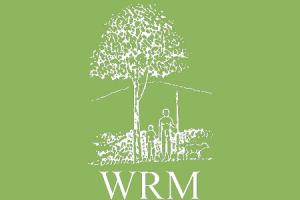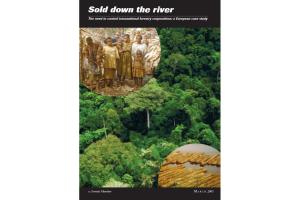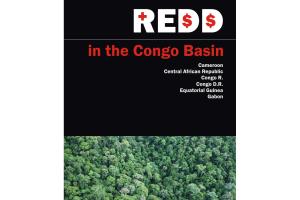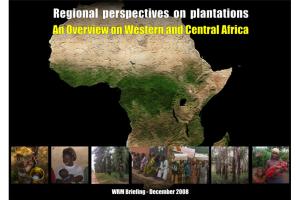Powerful countries and corporations have targeted the African continent to become a commodity supplier for their industrial needs. This has led to intense land grabbing with industrial oil palm plantations becoming in recent years a new source of land grabbing in many African countries.
Cameroon
Other information
30 April 2011
Other information
17 April 2011
Sold Down the River - The Need to Control Transnational Forestry Corporations: A European Case Study
By Forests Monitor, 2001
Sold Down the River - The Need to Control Transnational Forestry Corporations: A European Case Study
Publications
11 December 2010
The forest of the Congo Basin expands over an area of continuous tropical rainforest cover only second to that of the Amazon forest. Those forests are currently receiving a lot of attention within the Climate Change negotiations.
Bulletin articles
30 October 2010
Au milieu d’un désert vert de 60 000 hectares de plantations de palmiers à huile se trouvent 150 hectares de terres agricoles et boisées qui appartiennent au village d’Apouh A Ngog de la région d’Edéa, au Cameroun.
Le village en question, comme tant d’autres, est encerclé par les plantations et, depuis des années, est en conflit avec Socapalm, filiale locale du groupe français Bolloré [1].
Bulletin articles
29 July 2010
Most Baka, Bagyeli and Bakola, recognised as “people of the forest,” still rely on hunting and gathering to secure their livelihoods, and even though some also cultivate annual crops, the majority still rely on the forests. For them, the forest is their ancestral home, their reliable grocery, the root of their existence, and their customary right (seeWRM Bulletin Nº 87).
Other information
29 June 2010
After French industrialist Vincent Bolloré filed two lawsuits against Radio France Inter, both for alleged defamation regarding plantations operated by SOCAPALM (Société Camerounaise de Palmeraies), photographer Isabelle Alexandra Ricq and researcher Julien-François Gerber addressed ten lies typically used to defend Bolloré, one by one.
Bulletin articles
30 January 2009
To establish a communal forest may look like a good proposal. However, it may be not, according to many local villagers from the district of Dzeng (Center Province, Department of Nyong and So'o), who have denounced the attempt of the current Dzeng’s mayor to make use of their forest lands for commercial exploitation. Some 25.182 hectares of forest lands would be classified as a "communal forest", an intermediate category between logging concessions and community forests.
Other information
30 January 2009
This new publication of the WRM Series on Plantations (* ) examines resistances of populations neighboring two of Africa’s largest industrial tree plantations: the rubber monoculture Hévéa-Cameroun (HEVECAM) and the oil palm plantation Société Camerounaise de Palmeraies (SOCAPALM). The report intends to contribute to fill a lack of information on the situation around commercial plantations in Equatorial Africa.
Publications
22 December 2008
(Only available in French)
Populations locales versus plantations commerciales d’hévéas et de palmiers à huile dans le Sud-Cameroun
By Julien-François Gerber
Résistances contre deux géants industriels en forêt tropicale
Publications
15 December 2008
Oil palm and rubber plantations occupy extensive areas in many countries in tropical Africa. In spite of their social and environmental impacts, until now they have received scant attention both at the national and international level.
Bulletin articles
27 September 2008
In South-Western Cameroon, near Kribi, two giant industrial plantations cover a total area of 62,000 hectares. One of them, HEVECAM, is a rubber tree monoculture belonging to the Singapore-based GMG group, while the other, SOCAPALM, is an oil palm plantation, property of the French group Bolloré.
Bulletin articles
8 November 2007
One of the main characteristics of Cameroon’s economic policies since independence is their institutional promotion of large-scale industrial plantations. Between 1971 and 1981, the state allocated to them no less than 60% of the public funds reserved for agricultural development. The most important feature of these large-scale plantations was – and still is – their domination by only a few agro-industrial firms, highly protected, oligopolistic, and dependant on capital-intensive technologies.




